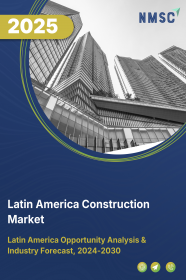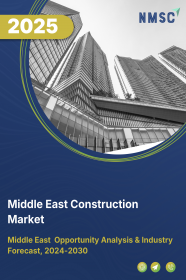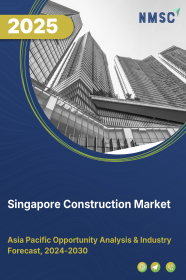
Latin America Construction Market by Type (Renovation, and New Construction), by Sector (Real Estate and Others), by Construction Method (Traditional Construction, Prefabricated/Modular Construction, 3D Printed Construction, Green/Sustainable Construction), and by Type of Contractor (Large Contractor, Medium Contractor and Small Contractor) – Regional Industry Trends and Forecast, 2025–2030
Industry: Construction & Manufacturing | Publish Date: 09-Sep-2025 | No of Pages: 132 | No. of Tables: 146 | No. of Figures: 91 | Format: PDF | Report Code : CM2225
Latin America Construction Industry Overview
The Latin America Construction Market size was valued at USD 464.50 billion in 2024, and is projected to grow to USD 491.83 billion by 2025. Additionally, the industry is expected to continue its growth trajectory, reaching USD 514.29 billion by 2030, with a CAGR of 0.9% from 2025 to 2030.
The Latin America construction market encompassing both real estate and infrastructure, is driving significant economic development through a diverse range of projects, from residential to large-scale infrastructure initiatives.
Effective collaboration among stakeholders such as architects, contractors, government bodies, and private investors plays a key role in this growth, as seen in major projects like Brazil's Porto Maravilha urban redevelopment. The sector is also advancing with a focus on sustainability, adopting eco-friendly practices and materials, as demonstrated by Chile’s Santiago Metro Line 7 project.
Despite these positive trends, the market faces challenges due to complex regulatory frameworks and lengthy permitting processes that can delay projects and increase costs. However, the ongoing digital transformation, particularly with the adoption of Building Information Modeling (BIM), AI, and IoT technologies, presents significant opportunities to improve project efficiency, collaboration, and resource management, further contributing to market expansion.
Diverse Project Scope and Integrated Infrastructure Programs Drive Construction Market Growth
The Latin America Construction Market—covering both real estate and infrastructure development—is a foundational pillar of economic progress, overseeing the full lifecycle of physical assets such as buildings, roads, energy facilities, and public spaces. The sector supports a variety of projects, including residential, commercial, industrial, transportation, and institutional developments. Growth is being propelled by national infrastructure modernization programs, urban regeneration efforts, and cross-border development initiatives such as regional logistics corridors.
A coordinated approach involving public and private stakeholders—such as urban planners, contractors, civil engineers, financial institutions, and local governments—is critical to the timely and effective delivery of these projects.
Technological Innovation and Climate Resilience Initiatives Accelerate Market Expansion
The construction sector is undergoing rapid transformation through the integration of digital technologies, such as Building Information Modeling (BIM), modular construction, and smart infrastructure systems, which enhance productivity, cost-efficiency, and project management.
Simultaneously, increasing attention to climate resilience and disaster risk reduction is fostering the development of structures that can withstand environmental hazards. Government incentives and international funding mechanisms are also encouraging the adoption of green certifications, renewable energy systems, and sustainable urban planning models.
These factors—coupled with a growing urban population and targeted public investment—are collectively driving sustained growth in the Latin America Construction Market.
Regulatory and Institutional Complexities Impede Infrastructure Progress
One of the primary restraints on the Latin American construction sector is the complexity and inconsistency of regulatory frameworks across the region. Large-scale infrastructure and urban development projects often encounter delays due to lengthy permitting processes, multi-tiered bureaucratic systems, and frequent changes in government policies.
Projects must typically comply with a wide array of regulatory requirements, including environmental impact assessments, municipal zoning laws, building and safety codes, and labor regulations—each managed by different government entities at the local, provincial, and national levels.
Inconsistencies between jurisdictions and limited institutional capacity to process permits or enforce compliance often led to protracted approval timelines, increased operational risks, and higher development costs. Political instability and policy reversals in certain countries further exacerbate uncertainty, deterring foreign investment and impeding long-term infrastructure planning.
Digitalization and Bim Adoption Offer Transformational Opportunities for Growth
The growing adoption of digital technologies, particularly Building Information Modeling (BIM), represents a major opportunity for transformation in the Latin America Construction Market. BIM allows for the creation of intelligent 3D models that integrate data throughout the construction lifecycle—enabling better planning, design, execution, and maintenance of projects.
Governments across the region, including Chile, Brazil, and Mexico, have begun developing national BIM strategies to drive innovation, reduce inefficiencies, and improve transparency in public infrastructure procurement. For instance, Chile’s Plan BIM initiative, led by the Ministry of Public Works and CORFO, mandates the use of BIM in public projects to improve coordination and reduce cost overruns.
As digital transformation accelerates, the use of BIM and related digital tools like cloud-based project management, IoT-enabled monitoring systems, and prefabrication technologies will boost productivity, optimize asset performance, and foster collaboration across public and private stakeholders—unlocking new efficiencies in both urban and rural infrastructure development.
Competitive Landscape
The key players operating in the Latin America construction industry include Acciona S.A, ACS Group, FCC Construccion, Techint Engineering & Construction, Empresa ICA, Sigdo Koppers, Grupo Carso, Andrade Gutierrez S.A, Construtora Camargo Correa, Odebrecht Engenharia & Construcao (OEC), Besalco S.A, SalfaCorp S.A, Constructora Meco S.A. (MECO), IDEAL (Impulsora del Desarrollo y el Empleo en América Latina), Ghella S.P.A. and others.
Latin America Construction Market Key Segments
By Type
- Renovation
- New Construction
By Sector
-
Real Estate
-
Residential
-
Affordable
-
Luxury
-
-
Commercial
-
Retail Buildings
-
Office Buildings
-
Hospitality
-
Healthcare Facilities
-
Educational Institutes
-
Entertainment Ventures
-
-
-
Infrastructure
-
Transportation
-
Airport
-
Port
-
Rail
-
Road
-
-
Water and Wastewater
-
Energy
-
Telecommunication
-
-
Industrial
-
Manufacturing Plant
-
Warehouses
-
Power Plants
-
Oil Refineries
-
Chemical Plants
-
By Construction Method
-
Traditional Construction
-
Prefabricated/Modular Construction
-
3D Printed Construction
-
Green/Sustainable Construction
By Type of Contractor
-
Large Contractor
-
Medium Contractor
-
Small Contractor
Key Players
-
Acciona S.A.
-
ACS Group
-
FCC Construccion
-
Techint Engineering & Construction
-
Empresa ICA
-
Sigdo Koppers
-
Grupo Carso
-
Andrade Gutierrez S.A.
-
Construtora Camargo Correa
-
Odebrecht Engenharia & Construcao (OEC)
-
Besalco S.A.
-
SalfaCorp S.A.
-
Constructora Meco S.A. (MECO)
-
IDEAL (Impulsora del Desarrollo y el Empleo en América Latina)
-
Ghella S.P.A.
Report Scope and Segmentation
|
Parameters |
Details |
|
Market Size in 2024 |
USD 464.50 Billion |
|
Revenue Forecast in 2030 |
USD 514.29 Billion |
|
Growth Rate |
CAGR of 0.9% from 2025 to 2030 |
|
Analysis Period |
2024–2030 |
|
Base Year Considered |
2024 |
|
Forecast Period |
2025–2030 |
|
Market Size Estimation |
Billion (USD) |
|
Growth Factors |
|
|
Companies Profiled |
15 |
|
Market Share |
Available for 10 companies |
|
Customization Scope |
Free customization (equivalent up to 80 working hours of analysts) after purchase. Addition or alteration to country, regional, and segment scope. |
|
Pricing and Purchase Options |
Avail customized purchase options to meet your exact research needs. |

















 Speak to Our Analyst
Speak to Our Analyst

























